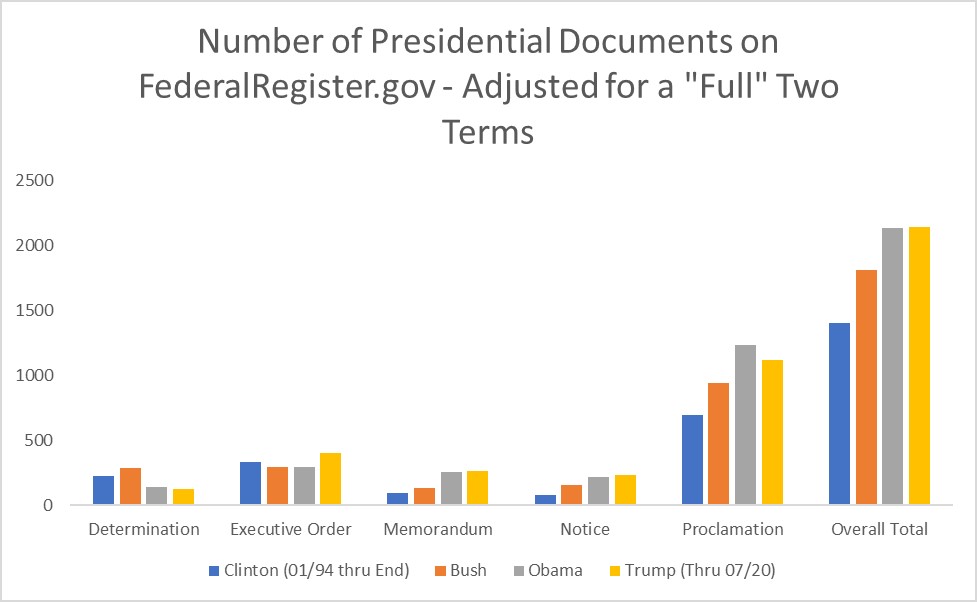Insight
August 6, 2020
Comparing the Pace of President Trump’s Executive Actions to Recent Predecessors
EXECUTIVE SUMMARY
- The long-running debate over the scope of a president’s power has become more pronounced in recent years, especially as recent presidents have had a propensity to issue direct actions.
- These direct actions can take a variety of forms, but all are largely at the full discretion of a given president and his policy preferences.
- Despite President Trump’s deregulatory focus and conservatives’ traditional skepticism toward unfettered executive authority, administrative data suggest that the president is currently on pace to exert this direct authority more than any of his three most immediate predecessors.
INTRODUCTION
The opening sentence of Section 1 of Article II of the United States Constitution states: “The executive power shall be vested in a President of the United States of America.” The question of how expansive this “executive power” ought to be has been at the core of many of the nation’s political debates since its earliest days. The exercise of executive authority can take myriad forms. In the modern administrative state, much of the substantive policymaking comes at the agency level in the complex, time-consuming rulemaking process. The president, however, can issue more direct and timely actions ranging from official orders to various memoranda and pronouncements.
In 2014, Republicans roundly criticized President Obama’s famous assertion of using his “pen and phone” in the face of congressional intransigence, but President Trump has hardly been reticent in issuing such orders himself – particularly on immigration issues. Recent reports suggest that more direct actions are forthcoming with regard to the COVID-19 response, as the president’s policy preferences run up against contrasting legislative efforts.
Given the growing number and political significance of such actions, it is worth briefly observing the historical context. An examination of the Federal Register’s data on direct presidential actions reveals that, even in the face of his administration’s overall deregulatory posture and Republicans’ usual concerns over the limits of executive actions, President Trump is currently on pace to be even more prolific on this front than the three administrations that preceded him.
TYPES OF DIRECT EXECUTIVE ACTION
This analysis focuses on documented actions coming directly from the president. The Federal Register breaks “Presidential Documents” out into the following sub-categories:

Executive Orders (EOs) are perhaps the most well-known and high-profile actions. These are generally wide-ranging documents that set some sort of policy directive across an entire administration. For instance, EO 13,771 establishes the “regulatory budget” process that all executive agencies are expected to follow. EOs are all still at a given president’s discretion, however. Some, such as EO 12,866 (the order that established the modern framework for regulatory cost-benefit analysis), can become long-standing policy across administrations, while others involve the direct recission of those from previous administrations.
The other types of action are narrower. A “Determination” is generally where a president makes a judgement on an issue that allows him to invoke some underlying statutory authority. A “Memorandum” is largely similar in form to an EO, but is much more restrained in scope, focusing on a very particular policy issue. The “Notice” category primarily consists of documents alerting the public that the administration is exerting or continuing to exert some time-constrained authority. A “Proclamation” is a statement of a president’s official sentiment on an issue; they can range from the ceremonial to the policy-setting when the underlying statute requires such pronouncements to take such a form. Similarly, the “Presidential Order” basket consists of documents where the underlying statute requires that precise verbiage. There are currently only three such documents, however, and thus they are largely irrelevant to this analysis.
BREAKING DOWN THE DATA
The online version of the Federal Register includes documents going back to 1994. Therefore, the total volume of such documents is readily available through part of President Clinton’s first term. The following chart shows the gross numbers of these documents:

In this format, it appears that President Obama is the runaway leader in such actions with 2,132 overall. Additionally, Trump appears to be behind all others across the board. It is important to note, however, the variability of the term lengths involved. The data account for the full two terms of Presidents Bush and Obama, but are incomplete for Clinton (again, only going to the start of 1994) and Trump (because he is still only partially through one term). More precisely, the available data account for roughly 88 percent of Clinton’s two terms. Whether or not Trump serves two terms remains an open question, but the end of July 2020 marks roughly 44 percent of a potential two-term tenure. Filling in these data gaps by extrapolating the Clinton and Trump pace across the remainder of two terms yields the following:

In this scenario, Trump would narrowly edge out Obama for the overall lead at 2,136 actions to the latter’s 2,132. Further, Trump is on pace for 399 EOs, which would be at least 60 more than any of the other presidents.
CONCLUSION
This analysis merely looks at the volume of executive actions, not the substantive impact of any given action or set of actions. Examining that aspect would necessarily be a more complicated and subjective exercise. Nevertheless, to the extent that the debate surrounding the limits of executive power centers on how often a president is inclined to assert this direct authority – especially when, as seen most recently under both Obama and Trump, those actions directly contradict the position of Congress – it is important to recognize such trends.










